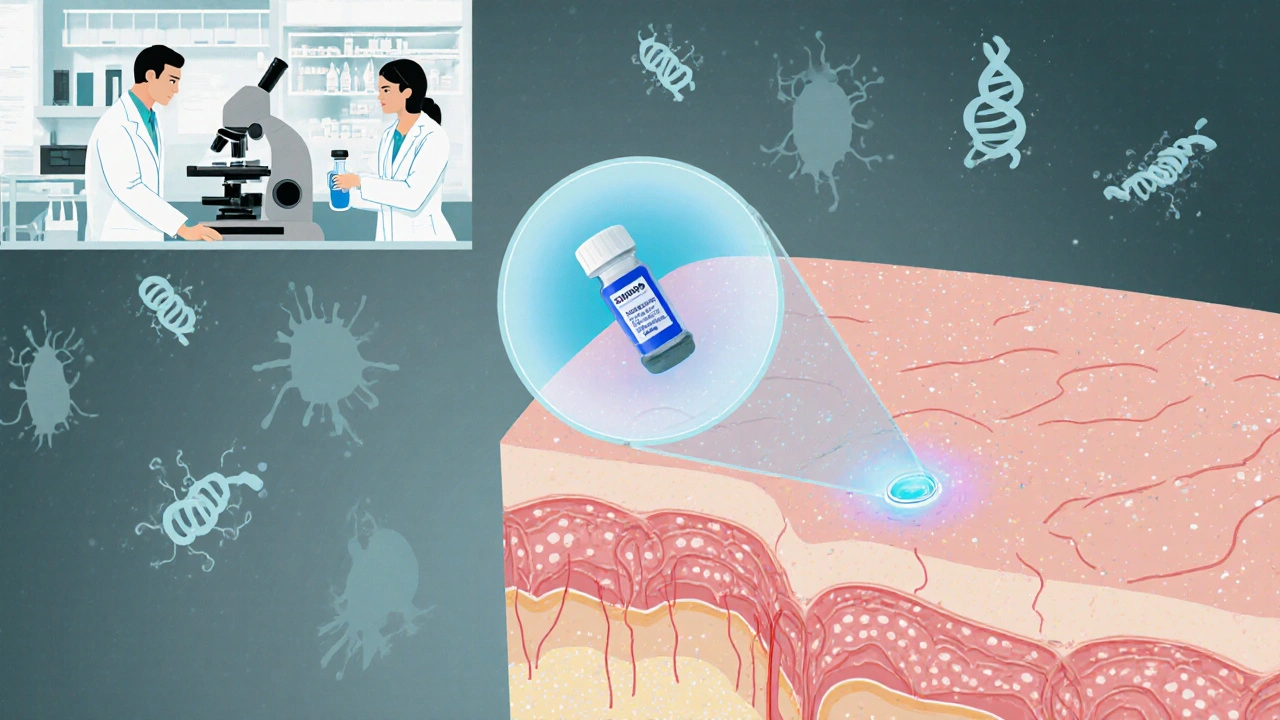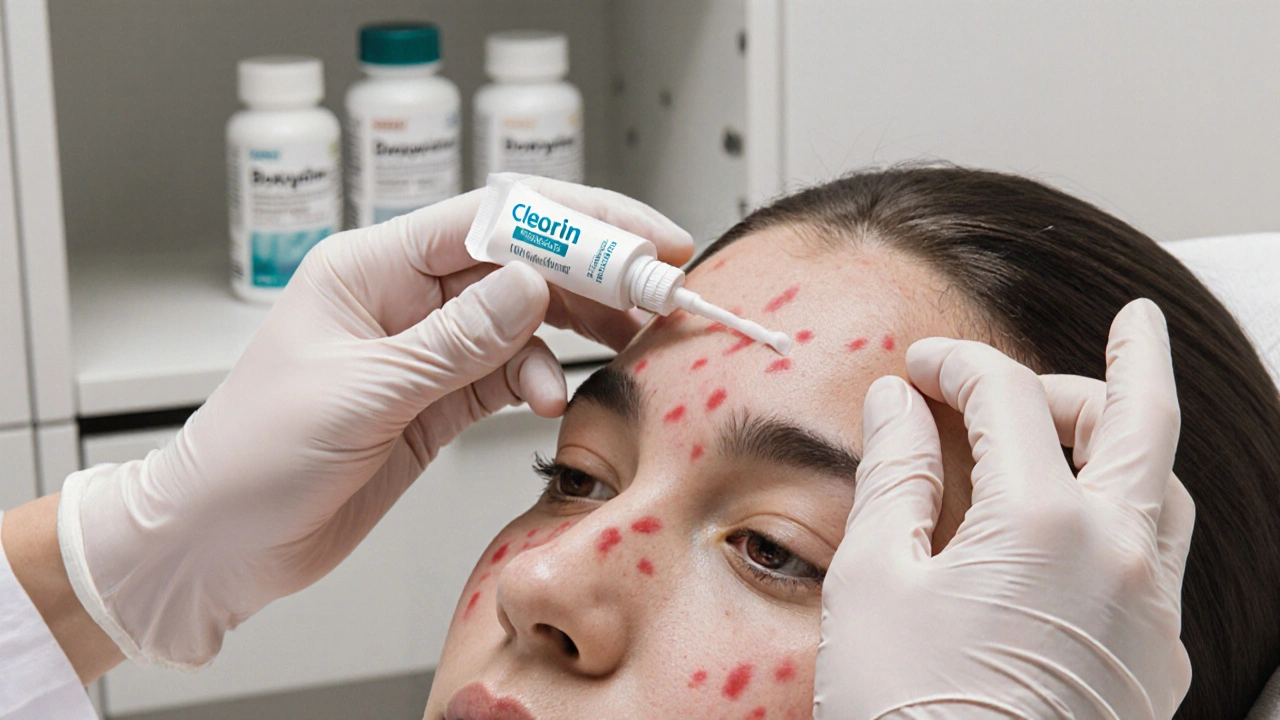Antibiotic Selection Tool
Find Your Best Antibiotic Match
Answer a few questions to get personalized recommendations for acne or skin infections based on the latest medical guidelines.
Recommended Antibiotic
When treating bacterial skin issues, Cleocin is a brand name for clindamycin, a lincosamide antibiotic available in topical and oral forms. It’s a go‑to for moderate acne and certain soft‑tissue infections, but dozens of other drugs can do the job. This guide lines up the most common alternatives, shows where each shines, and helps you pick the right one without the guesswork.
Key Takeaways
- Cleocin works by stopping bacterial protein synthesis; it’s especially good for Acne vulgaris and anaerobic skin infections.
- Oral tetracyclines (doxycycline, minocycline) have broader coverage but higher risk of photosensitivity.
- Topical erythromycin and benzoyl peroxide are cheaper, but resistance builds faster.
- Retinoids such as tretinoin treat acne by unclogging pores rather than killing bacteria.
- Cost, side‑effects, pregnancy safety, and local resistance patterns decide the best fit.
What Is Cleocin (Clindamycin)?
Clindamycin belongs to the lincosamide class. It binds to the 50S ribosomal subunit of bacteria, halting protein production. The drug comes in two main formats:
- Topical gel or lotion (1%) - applied twice daily for acne or minor bacterial skin infections.
- Oral capsules (75‑300mg) - prescribed for deeper infections like cellulitis, abscesses, or severe acne.
Typical acne dosage is 1% gel for 12weeks; oral therapy often runs 4‑12weeks, depending on severity. Because it targets Gram‑positive and anaerobic organisms, clindamycin is less useful against resistant Propionibacterium acnes strains that have developed after long‑term use.
How Do the Alternatives Stack Up?
Below is a side‑by‑side look at the most frequently prescribed options. All figures reflect Australian 2025 data where relevant.
| Drug | Class | Typical Use | Mechanism | Pros | Cons | Typical Cost (AU$) per month |
|---|---|---|---|---|---|---|
| Cleocin (Clindamycin) | Lincosamide | Acne, cellulitis, bone‑joint infections | Inhibits 50S ribosomal subunit | Effective against anaerobes; good topical penetration | Risk of C.difficile colitis; resistance after >3months | ~30 (topical) - 45 (oral) |
| Doxycycline | Tetracycline | Moderate‑to‑severe acne, rosacea, respiratory infections | Blocks 30S ribosomal subunit | Broad spectrum, anti‑inflammatory; low resistance rates | Photosensitivity, GI upset; not for pregnancy | ~25 |
| Minocycline | Tetracycline | Severe acne, MRSA skin infections | Inhibits 30S ribosomal subunit | Long half‑life, works on resistant strains | Potential vestibular side‑effects; discoloration of teeth | ~28 |
| Erythromycin | Macrolide | Topical acne, mild bacterial skin infections | Binds 50S ribosomal subunit | Cheap, widely available | Rapid resistance; GI cramps | ~12 |
| Benzoyl Peroxide | Oxidizing agent | Acne (as monotherapy or combo) | Generates free radicals that kill bacteria | No resistance, quick action | Skin irritation, bleaching of fabrics | ~8 |
| Tretinoin (Retinoid) | Retinoic acid derivative | Comedonal acne, anti‑aging | Modulates keratinocyte differentiation | Reduces pore blockage, improves texture | Initial irritation, photosensitivity | ~20 |
When to Choose Cleocin Over the Others
If you need a medication that hits both aerobic Gram‑positive skin flora and anaerobes, clindamycin is a solid bet. It’s especially useful when:
- You have a mixed infection (e.g., a superficial abscess with anaerobic components).
- Topical therapy is preferred to avoid systemic side‑effects.
- Patient is pregnant or breastfeeding - clindamycin is Category B in Australia, while doxycycline is contraindicated.
However, limit continuous use to under three months for acne because resistance can rise sharply. Pairing with benzoyl peroxide or a retinoid helps keep bacterial counts low.
Strengths and Weaknesses of Each Alternative
Doxycycline shines when you need anti‑inflammatory action alongside antimicrobial coverage. It’s the first‑line oral drug for adult acne, but you must warn patients about sun exposure.
Minocycline is often reserved for tough cases where doxycycline fails or when MRSA is suspected. Its longer half‑life means fewer doses, yet the risk of dizziness or skin discoloration makes it a second‑line choice for younger patients.
Erythromycin is cheap and handy for short‑term topical use, but resistance rates exceed 50% in many Australian cities, so it’s rarely used alone.
Benzoyl peroxide isn’t an antibiotic, but it kills P. acnes by oxidation. Use it in the morning to avoid irritation at night, and you’ll reduce the chance of resistance developing to any antibiotic you add.
Tretinoin tackles the root cause of acne-blocked pores-rather than the bacteria. It works best in a regimen that also includes an antibiotic or peroxide to control inflammation during the first few weeks.
Cost, Availability, and Insurance Coverage in Australia
Most of these drugs are listed on the Pharmaceutical Benefits Scheme (PBS). Cleocin gel is subsidised for severe acne, while oral clindamycin may require a private prescription. Doxycycline and minocycline are both PBS‑listed for acne, often with lower out‑of‑pocket costs than brand‑name clindamycin gel. Generic erythromycin and benzoyl peroxide are available over‑the‑counter, making them the most budget‑friendly options.
Potential Side‑Effects and How to Mitigate Them
Every antibiotic carries a risk of gut disturbance. For clindamycin, the biggest red flag is Clostridioides difficile infection. To lower risk:
- Use the shortest effective course.
- Pair oral therapy with probiotics containing Lactobacillus rhamnosus.
- Monitor for watery, foul‑smelling stools and seek medical help immediately.
Tetracyclines can cause photosensitivity; advise sunscreen SPF30+ and protective clothing. Minocycline’s vestibular side‑effects often subside after the first two weeks, but if dizziness persists, switch to doxycycline.

Decision Checklist - Which Drug Fits Your Situation?
| Clinical Need | Best Choice | Why? |
|---|---|---|
| Pregnant or lactating patient | Cleocin (topical) | Category B, minimal systemic absorption |
| Rapid anti‑inflammatory effect | Doxycycline | Anti‑inflammatory properties reduce lesion redness |
| MRSA‑suspected skin infection | Minocycline | Effective against many resistant strains |
| Budget‑tight, mild acne | Benzoyl peroxide | Cheap, no resistance, works as monotherapy |
| Comedonal acne without inflammation | Tretinoin | Unclogs pores, improves skin turnover |
How to Use Cleocin Safely
- Clean the affected area with a mild cleanser; pat dry.
- Apply a pea‑size amount of 1% gel to each lesion, twice daily (morning and evening).
- Wait 15‑20 minutes before layering other products to avoid dilution.
- Do not exceed 12weeks without a dermatologist’s review.
- If using oral clindamycin, take with food to lessen stomach upset.
Combine with a non‑comedogenic moisturizer to counteract dryness.
Future Outlook - Resistance Trends in 2025
Australian surveillance shows a 22% increase in clindamycin‑resistant P. acnes isolates over the past two years. The rise correlates with prolonged monotherapy use. Dermatologists now recommend rotating antibiotics every 3‑4months or adding a non‑antibiotic agent (peroxide or retinoid). Ongoing clinical trials are testing a new liposomal clindamycin formulation that may deliver higher skin concentrations with lower systemic exposure.
Frequently Asked Questions
Can I use Cleocin gel and benzoyl peroxide together?
Yes. Applying benzoyl peroxide in the morning and Cleocin gel at night minimizes irritation while maximizing antibacterial action. Start with every‑other‑day use of peroxide to see how your skin reacts.
Is clindamycin safe during pregnancy?
Topical clindamycin is classified as Category B in Australia, meaning it’s considered safe based on animal studies and limited human data. Oral clindamycin is generally avoided unless the infection is severe and no safer alternative exists.
Why did my acne get worse after a month of using Cleocin?
Bacterial resistance can develop after 8‑12weeks of continuous use. Adding a retinoid or benzoyl peroxide, or switching to a different class (e.g., doxycycline), usually restores improvement.
How does minocycline compare to doxycycline for acne?
Both are tetracyclines, but minocycline has a longer half‑life and may work on some doxycycline‑resistant strains. Its downside is a higher chance of vestibular side‑effects and tooth discoloration, making doxycycline the first choice for most adults.
What should I do if I develop severe diarrhea while on clindamycin?
Stop the antibiotic immediately and contact a healthcare professional. Severe watery diarrhea could signal C.difficile infection, which requires specific treatment.


Jesse Groenendaal
October 12, 2025 AT 03:59If you’re not checking resistance patterns you’re basically flirting with failure.
Persephone McNair
October 18, 2025 AT 11:23The pharmacodynamic profile of clindamycin hinges on its affinity for the 50S ribosomal subunit, yielding bacteriostatic activity against anaerobic Gram‑positive flora while sparing commensals-a nuance often overlooked in primary care.
siddharth singh
October 24, 2025 AT 18:46Clindamycin remains a cornerstone in dermatologic therapy because its mechanism of action directly targets the 50S ribosomal subunit of anaerobic Gram‑positive organisms.
When applied topically at 1 % concentration, the drug achieves sufficient epidermal concentrations to suppress Propionibacterium acnes without systemic exposure.
Systemic administration, however, must be approached with caution due to the well‑documented risk of Clostridioides difficile colitis, which can be life‑threatening.
The current guidelines recommend limiting oral courses to a maximum of three months for acne to mitigate the development of resistant strains.
Concurrent use of benzoyl peroxide not only reduces bacterial load but also prevents resistance by providing a non‑antibiotic oxidative kill.
Patients who are pregnant should be steered toward the topical formulation because it is classified as Category B and does not cross the placenta in significant amounts.
For severe infections such as cellulitis, clindamycin’s excellent anaerobic coverage makes it preferable over many tetracyclines which lack activity against anaerobes.
Cost considerations also play a role; while generic clindamycin gel can be pricier than over‑the‑counter benzoyl peroxide, many insurance plans subsidize it for refractory acne.
Monitoring liver function tests is advisable during prolonged oral therapy because rare hepatotoxicity has been reported.
If a patient develops diarrhea, the clinician should immediately assess for C. diff difficile toxin and discontinue the drug if positive.
Probiotics containing Lactobacillus strains may alleviate mild gastrointestinal disturbances, though evidence remains anecdotal.
Switching to a tetracycline such as doxycycline can be effective after clindamycin failure, provided the patient is not pregnant and can tolerate photosensitivity.
In cases of MRSA‑suspected skin infection, minocycline may offer broader coverage, but clindamycin retains activity against many community‑acquired strains.
Ultimately, the decision tree should incorporate infection severity, patient comorbidities, and local resistance patterns to achieve optimal outcomes.
By adhering to these evidence‑based principles, clinicians can preserve clindamycin’s utility while minimizing adverse events and resistance.
Angela Green
October 31, 2025 AT 02:09Your post contains several punctuation oversights; for instance, the list items should end with periods, not commas.
Also, “Clindamycin” should be consistently capitalized throughout the article.
April Malley
November 6, 2025 AT 09:32I totally agree with the idea that combining benzoyl peroxide with clindamycin can curb resistance, especially for those battling stubborn acne, and the cost factor is something many patients keep asking about, so it’s great you included that information, plus the safety profile during pregnancy is a huge plus for many readers, really helpful!
scott bradshaw
November 12, 2025 AT 16:55Wow another 'must‑read' guide about antibiotics, because we totally needed more of those.
Crystal Price
November 19, 2025 AT 00:19The world is so unfair when a simple breakout turns into a nightmare and you’re told the only answer is a pricey prescription.
Murhari Patil
November 25, 2025 AT 07:42They’re hiding the real cure from us the pharma giants only want us to chase cheap spots and never see the truth about natural alternatives.
kevin joyce
December 1, 2025 AT 15:05The ontological implications of antimicrobial stewardship extend beyond mere clinical outcomes, embodying a dialectic between human agency and microbial adaptation.
In the context of clindamycin’s pharmacokinetic profile, the balance between cutaneous bioavailability and systemic exposure invites a nuanced ethical calculus.
By integrating adjunctive oxidizing agents, we not only attenuate selective pressure but also honor the principle of non‑maleficence.
Thus, the therapeutic algorithm you outlined resonates with a broader moral architecture that privileges both efficacy and ecological responsibility.
michael henrique
December 7, 2025 AT 22:28Stop hyping generic articles, real treatment decisions should be made by American doctors who understand the market.